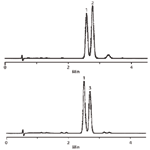Fast and Accurate LC–MS Analysis of Vitamin D Metabolites Using Ascentis® Express F5 HPLC Columns
The Application Notebook
Vitamin D deficiency has become a topic of interest in recent publications (1–3). Vitamin D is present in two forms, Vitamin D3 and Vitamin D2. D3 is produced after ultraviolet light-stimulated conversion of 7-dehydrocholesterol in the skin (3).
Vitamin D deficiency has become a topic of interest in recent publications (1–3). Vitamin D is present in two forms, Vitamin D3 and Vitamin D2. D3 is produced after ultraviolet light-stimulated conversion of 7-dehydrocholesterol in the skin (3). Vitamin D2 is derived from plant sources. Both D2 and D3 are metabolized in the liver to form 25-hydroxyvitamin D2 (25-OH D2) and 25-hydroxyvitamin D3 (25-OH D3), respectively. In addition, biologically inactive 3-epi analogs of 25-OH D2 and 25-OH D3 have been reported, especially in young children (3). The levels of the 25-hydroxy metabolites are routinely measured for diagnostic assessment of vitamin D related diseases; however, recent studies have indicated that separation from the inactive 3-epi analogs may provide more accurate information for treatment and prevention. Analytical methods that can accurately quantitate both of the 25-hydroxyvitamin D analytes in the presence of 3-epi analogs may become essential for diagnosis and monitoring of patients with vitamin D disorders.
LC–MS analysis of 25-OH D2 and 25-OH D3 is classically performed using C18 stationary phases. Under such conditions, the 3-epi analogs are not resolved and thus are included in the overall reported value. Recently, Phinney and colleagues, reported the use of a cyano column for the effective separation of the 25-OH and the 3-epi forms for use in reference measurement procedures (1). Although effective, the conditions necessitate a run time of better than 40 min limiting its utility for routine high-throughput analyses.
As an outcome of some recent application development efforts, it was observed that Ascentis Express F5 stationary phase provided increased selectivity toward 25-OH D3 and the corresponding 3-epi analog relative to reported methods. This report provides a brief synopsis of continuing efforts to assess the potential impact of this additional selectivity on routine clinical vitamin D diagnostics.
Discussion
The initial conditions were adopted for fast LC–MS methodology. Figure 1 shows some preliminary results indicating that 25-OH D3 and 3-epi-25-OH D3 can be rapidly resolved. 25-OH D2 and 3-epi-25-OH D3 coelute under these high throughput conditions, however they are easily resolved by mass response. The methodology thus enables quantification of all three components in one analysis.

Figure 1: Fast, LCâMS analysis of vitamin D metabolites using Ascentis Express F5. Column: Ascentis Express F5, 10 cm à 2.1 mm I.D., 2.7 μm (53569-U), Mobile phase: 25% 5mM ammonium formate water, 75% 5mM ammonium formate methanol, Flow rate: 0.4 mL/min., Temp: 40 °C, Inj. vol.: 1 μL, UV detection: 265 nm, MS detection: m/z 100-1000, Peaks: 1. 25-Hydroxyvitamin D3 (2.57 min), 2. 3-epi-25-Hydroxyvitamin D3 (2.76 min), 3. 25-hydroxyvitamin D2, (2.77 min). Top: Separation of 25-Hydroxyvitamin D3 and 3-epi-25-Hydroxyvitamin D3. Bottom: Analysis of 25-Hydroxyvitamin D3 and 25-Hydroxyvitamin D2.
Conclusions
Separation of the biologically inactive 3-epi analog may serve to provide improved data in support of vitamin D related clinical diagnostics and treatment. The pentafluorophenyl stationary phase has been shown to provide superior selectivity for the separation of the closely related 25-OH D3 and 3-epi-25-OH D3 as compared to methods reported in the literature. Initial efforts to show selectivity in a fast, LC–MS system provides promising evidence for implementation in real-world situations.
References
(1) S.S .-C. Tai, M. Bedner, and K.W. Phinney, Analytical Chemistry 82, 1942–1948 (2010).
(2) T. Higashi, S. Homma, H. Iwata, and K. Shimada, Journal of Pharmaceutical and Biomedical Analysis 29, 947–955 (2002).
(3) T. Higashi, K. Shimada, and T. Toyo'oka, Journal of Chromatography B 878, 1654–1661 (2010).
Supelco/Sigma-Aldrich
595 North Harrison Road, Bellefonte, PA 16823
tel. (800) 359-3041, fax (800) 359-3044
Website: www.sigma-aldrich.com

New Method Explored for the Detection of CECs in Crops Irrigated with Contaminated Water
April 30th 2025This new study presents a validated QuEChERS–LC-MS/MS method for detecting eight persistent, mobile, and toxic substances in escarole, tomatoes, and tomato leaves irrigated with contaminated water.
Accelerating Monoclonal Antibody Quality Control: The Role of LC–MS in Upstream Bioprocessing
This study highlights the promising potential of LC–MS as a powerful tool for mAb quality control within the context of upstream processing.
University of Tasmania Researchers Explore Haloacetic Acid Determiniation in Water with capLC–MS
April 29th 2025Haloacetic acid detection has become important when analyzing drinking and swimming pool water. University of Tasmania researchers have begun applying capillary liquid chromatography as a means of detecting these substances.

.png&w=3840&q=75)

.png&w=3840&q=75)



.png&w=3840&q=75)



.png&w=3840&q=75)



















